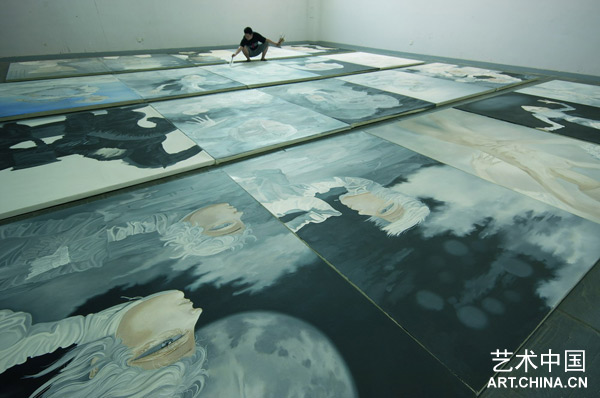
塔羅——熊宇個(gè)展
展覽時(shí)間:2008年10月10日至11月25日
開幕酒會(huì):2008年10月10日17:00
地 點(diǎn):環(huán)碧堂畫廊
地 址:北京市朝陽區(qū)百子灣路甲16號(hào)易構(gòu)空間7號(hào)樓2、3層
電 話:010-87746332
傳 真:010-87746339
郵 箱:chinabluegallery@yahoo.com.cn
網(wǎng) 址:www.chinabluegallery.com
熊宇新的主題展覽《塔羅》將于10月10日在環(huán)碧堂畫廊開幕。這組作品以塔羅牌的22張大阿爾卡那牌圖像為主題,是熊宇歷盡幾年時(shí)間潛心創(chuàng)作而成。熊宇以塔羅為契機(jī),將自己的內(nèi)心世界外化在塔羅牌里,借此表達(dá)自己對(duì)于世界、人生的看法。
塔羅牌相傳起源于古埃及的《叨忒之書》,是法老用來占卜和做出決策的。后被繪成卡片通過祭祀流傳下來并傳入歐洲,并在中世紀(jì)成為普遍使用的占卜手段,與占星術(shù)、占數(shù)術(shù)一起成為神秘學(xué)的代表之一。塔羅牌具有完備的自我體系,依托78種基本的性質(zhì),以及它們的兩個(gè)可能的方向,將整個(gè)世界無限發(fā)展變化囊括其中。卡爾?榮格(Carl Jung)第一次將塔羅牌視為象征性原型,用于心理學(xué)研究,成為分析個(gè)性的重要依據(jù)。
在這組作品中,典型的熊宇式人物有著水一樣的眼眸,常常長著羽狀的翅膀,代表著人所能達(dá)到的自由。他去除掉以前較為厚重的畫面鋪陳,讓原本就純化的顏色因此更顯出清逸,營造出類似失重的飛揚(yáng)狀態(tài),這樣的狀態(tài)很直接就把熊宇渴望訴達(dá)的內(nèi)心活動(dòng)軌跡給點(diǎn)明。在每一張作品中,熊宇不是以闡釋塔羅牌的角色為目的,而是寓涵了自己對(duì)于世界的聯(lián)想,從每一張牌中生發(fā)出不同的認(rèn)知和體驗(yàn)。例如〈愚人〉,傳統(tǒng)這個(gè)牌面一定會(huì)出現(xiàn)旭日、懸崖;一個(gè)打扮近似小丑的人,滿臉帶笑卻一只腳已經(jīng)踏在懸崖外。這張牌面其實(shí)用來隱喻一個(gè)人并不清楚自己正面臨什么狀況。熊宇在詮釋這張牌面時(shí),就舍棄懸崖這個(gè)環(huán)節(jié),他以一個(gè)正飛躍在半空中的人物為主圖像,藍(lán)天白云,絲毫看不出任何安全與危險(xiǎn)的可能性。或許傳統(tǒng)的塔羅牌面對(duì)于愚人的觀感,會(huì)比較傾向于不聰明或有點(diǎn)失瘋狀況的描述。可是,在熊宇的解讀中,愚人的定義不再那樣的窄化,因?yàn)椋?dāng)每個(gè)人所處的位置與角色不同的時(shí)候,所做出的決定對(duì)于某些人或許是蠢極,就另外的人則會(huì)是正確的選擇。熊宇不斷從一個(gè)現(xiàn)代語意學(xué)里去推翻舊思維樣貌,展現(xiàn)一個(gè)很符合自己背景的思考范疇。
云上的占卜者
為內(nèi)心的自我,所做的一份說帖

Tarot- Xiong Yu Solo Exhibition
Dates: 10th October – 25th November
Opening Reception: Friday 10th October, from 5pm
Venue: Chinablue Gallery
Address: 2-3/F, Bldg. 7, Jia 16 Baiziwan Road, Chaoyang District, Beijing
Tel: 010-87746332
Fax: 010-87746339
Email: chinabluegallery@yahoo.com.cn
Web: www.chinabluegallery.com
Xiong Yu’s new exhibition Tarot will open at Chinablue Gallery on the 10th of October. It takes the 22 tarot cards of the Major Arcana (the trump cards) as its theme and is the product of almost three years work. Xiong Yu has used the theme of tarot cards to portray an external image of his own inner world, his vision of life and the world.
Legend has it that tarot cards originate from the Ancient Egyptian Book of Thoth, which was used as a divination and decision-making tool by the Pharaohs. The book was later sacrificed to prevent its contents falling into enemy hands, transposed onto a set of pictorial cards, which subsequently made their way to Europe to evolve into the divination cards we know today. Alongside astrology and numerology, they have become one of the pillars of occult science. Tarot cards’ fully integrated system relies upon 78 basic human characters, each with their respective dichotomies, to encompass unlimited possibilities of the world. Psychoanalyst Carl Jung viewed tarot cards as symbolic archetypes, which he used as important indicators in working with patients.
This series of works sees Xiong Yu’s classic figures, with their emerald eyes and long feathery wings, represent man’s potential freedom. He has done away with the heavy ornamentation from before, bringing out purity in the work and giving a sense of weightlessness to the paintings – something that has allowed Xiong Yu to highlight directly his inner world’s activity. Xiong Yu’s goal with each card isn’t to explain its meaning but rather to embody his own worldview. With each card comes different understandings and experience. The first tarot card The Fool, for example, traditionally features a rising sun over a steep cliff. Dangling one foot over the cliff edge is a figure playing the joker, sporting a broad smile as he does so. This card is used as a metaphor for someone who doesn’t realise the precarious situation they are actually facing. However, Xiong Yu’s interpretation of this card has done away with the cliff entirely. It features a figure flying down against a backdrop of blue sky and white clouds, with seemingly no danger or threat in sight. Traditional impressions of a fool were perhaps centred on the idea of someone who was either rather stupid or losing their mind but Xiong Yu’s definition of a fool is clearly not so narrow. When everyone’s roles and positions are so different, something that might seem stupid for one person could seem quite sensible for another. Thus Xiong Yu attempts to reinterpret ancient thought with contemporary semantics, exhibiting a mind-set representative of his own surroundings.
 林間的騎者 200x450cm 布面油畫 2008 Riders in the Forest
林間的騎者 200x450cm 布面油畫 2008 Riders in the Forest
|

